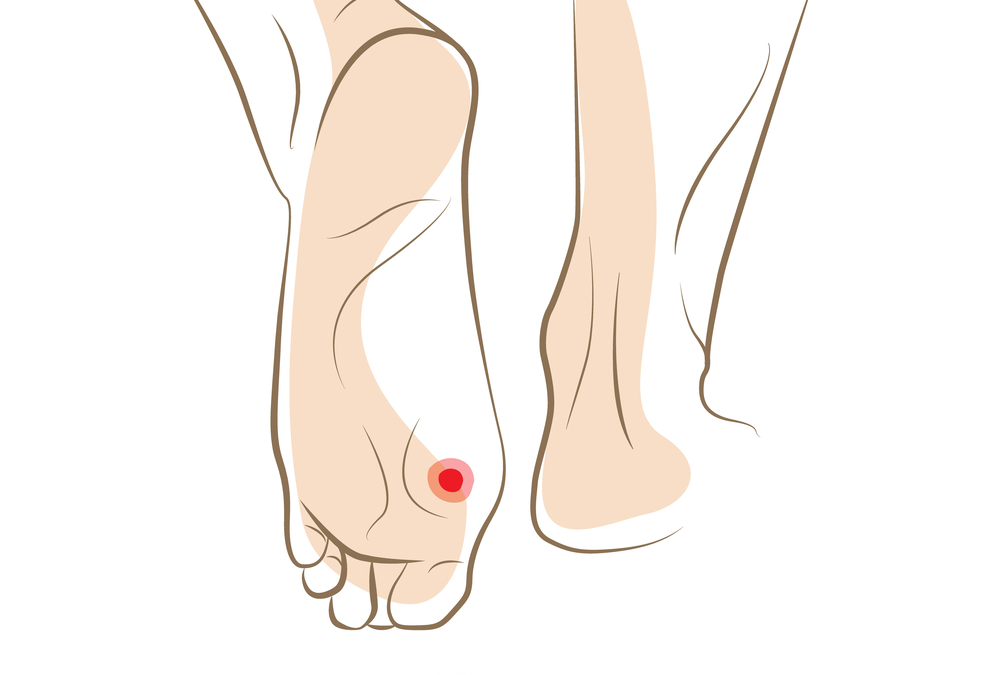Your body keeps score of everything, from the foods you eat to the exercise you undertake. As the largest organ in the body, the skin keeps its own treatment tally. Corns and calluses are simply ways to even the score. They cushion high-impact areas of the feet but can also cause complications in certain people. Understanding your risk factors – whether you live in Victoria, Kelowna, or Nanaimo – can help protect your health.
Residents in Victoria, Kelowna, and Nanaimo: When Should You Seek Treatment for Corns and Calluses?
Identified as patches of rough, hardened skin on the feet, corns and calluses form in response to friction or a pressure source. They often develop over a long period of time, and ill-fitting shoes are common culprits. Calluses appear in weight-bearing locations, like the soles of the feet, and are usually long and flat. Corns tend to develop along the toes and are more cone-shaped.
Both calluses and corns are the body’s way of protecting those areas of your feet that work the hardest – it’s better to have one of these conditions than an open sore. And they can often be remedied by wearing more supportive shoes and/or applying moisturizing cream to the areas. But in certain cases, you need to seek treatment to ensure calluses and corns are properly managed.
If You’re Diabetic
If you’re diabetic, the elevated levels of blood glucose present in your body put you at greater risk of prolonged cuts, sores, and infections. High blood glucose levels can also have serious effects on the nerve endings in your feet and cause numbness or pain. Blood circulation is likely to be affected as well, therefore impairing your body’s natural maintenance tasks.
Because healing is impaired, thick calluses and corns can disguise the presence of foot ulcers. When left untreated, these ulcers can become infected and advance to a degree that puts your entire foot at risk.
Different Needs
Routine care of calluses and corns is much different for diabetics than non-diabetics. To illustrate, medicated liquids often purchased to relieve corns cannot distinguish between live and dead skin. While a healthy foot can likely handle damage to living skin cells, a diabetic foot might not.
Tools like pumice stones and files can cause similar damage. They’re not sterile, and because they can abrade or break the skin, they can also create entry points for bacteria – bacteria that can cause serious illness. Many diabetics have compromised immunity and, as mentioned earlier, poor healing responses. The best option is to seek medical care from an experienced podiatry team in Nanaimo.
If Your Corns Have Turned from Pesky to Painful
Corns may seem like minor inconveniences, but they often cause pain severe enough to interfere with an active Victoria lifestyle. They have knobby cores that point inward and place pressure on nearby nerves. This pressure can cause sharp pain that makes even the simple task of walking difficult.
Corns can develop in places where it’s impossible to avoid them, such as the soles of the feet or between toes. Over-the-counter remedies that promise relief often lead to even bigger problems. To illustrate, products formulated with salicylic acid dissolve the keratin that comprises the corn and dead layer of skin on top of it. But for some people, this acid causes infections and burns that are more damaging than the corn itself.
You Have Fragile Skin
As skin ages, it loses its natural strength and becomes increasingly more fragile. Unfortunately, fragile skin is more susceptible to infections. This is especially true of feet that spend most of their time in closed, moist environments.
These conditions are ideal for breeding bacteria, and staph infections can develop when bacteria enter corns through tears or breaks in thin skin. The corn can, in turn, become infected and release fluid or pus. If you have fragile skin combined with corn, a Kelowna podiatrist can develop a treatment plan that protects you and your health.
If Calluses and Corns Keep Coming Back
When calluses and corns return for a third, fourth, or fifth time, Nanaimo patients often ask if the “roots” can simply be removed – much like pulling the roots of a tree after it’s been cut down. But corns and calluses do not work this way. They don’t have roots, and recurrences may indicate a more fundamental underlying problem. A structural misalignment or bone spur, for instance, may be placing extra pressure on the skin in a specific area.
These issues are largely determined by genetics, but bone spurs can also be caused by osteoarthritis. Calluses and corns sometimes develop in response to structural concerns and are not independent growths. The center spot often visible in a corn looks like a root but is actually the focal point of pressure. As a result, this spot develops more thickly than the rest of the lesion.
Treatment Options
Going to a podiatrist for recurring calluses and corns allows you to identify the true cause and take the necessary steps to end you’re suffering. Carefully paring down the excess skin can end pain, while custom orthotics that go directly into your shoes can prevent additional pressure. Surgery may be another option, in which the underlying foot concern is manually corrected.
The point is this: going to the podiatrist can provide symptomatic relief and alert you to the REAL root of the problem. Together with your medical team, you can then decide which treatment option is right for you.
Discerning Fact from Fiction
When it comes to foot care, people from Victoria to New York City have devised home remedies they think will soften skin and whisk away bacteria. One of the most popular – and dangerous – of these is soaking feet in mouthwash to eliminate calluses and corns.
Likewise, many people attempt to cut out the corn “root” we just discussed at length. Both of these activities, however, can cause permanent damage to your foot – the former can lead to skin burns and the latter can promote bacterial infections. It’s much safer and far more effective to let a podiatrist treat calluses and corns.
Myth: Calluses and Corns Are Normal
This is unequivocally false, and you shouldn’t be forced to live in pain because you think it’s normal. Plenty of treatment options exist. You need only to let your Kelowna podiatrist develop a therapy plan that aligns with your overarching health needs.
Myth: Calluses and Corns Are Different
In truth, these two concerns are the same. “Callus” and “corn” are simply descriptive terms used to distinguish between the outer skin patches that form in response to friction.
Myth: Calluses and Corns Are Always Caused by Foot Deformities
Many factors can contribute to calluses and corns, not just structural misalignments. Wearing shoes without socks and even walking outside barefoot are two common offenders. The smooth, hairless skin found on feet and hands is physiologically designed to easily callus because these spots bear the brunt of friction and pressure.
Calluses often begin as blisters, and when repeated rubbing doesn’t abate, the body shifts into a more protective mode. Corns are similarly part of the body’s natural bumper system designed to safeguard skin from injury.
Calluses and corns can be unsightly and painful. They can also lead to additional health problems, especially if they recur or afflict people with diabetes or fragile skin. Fortunately, we’re here to help manage foot concerns and can pad or trim calluses and corns as well as prescribe custom orthotics. We can also perform surgery as necessary. Schedule your appointment today by contacting Island Foot Clinics.

